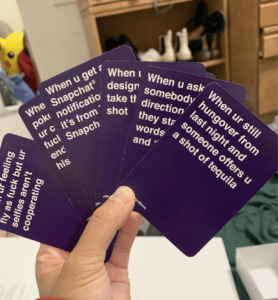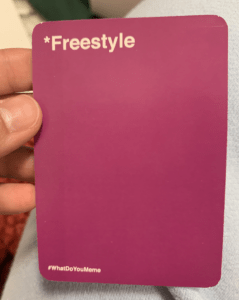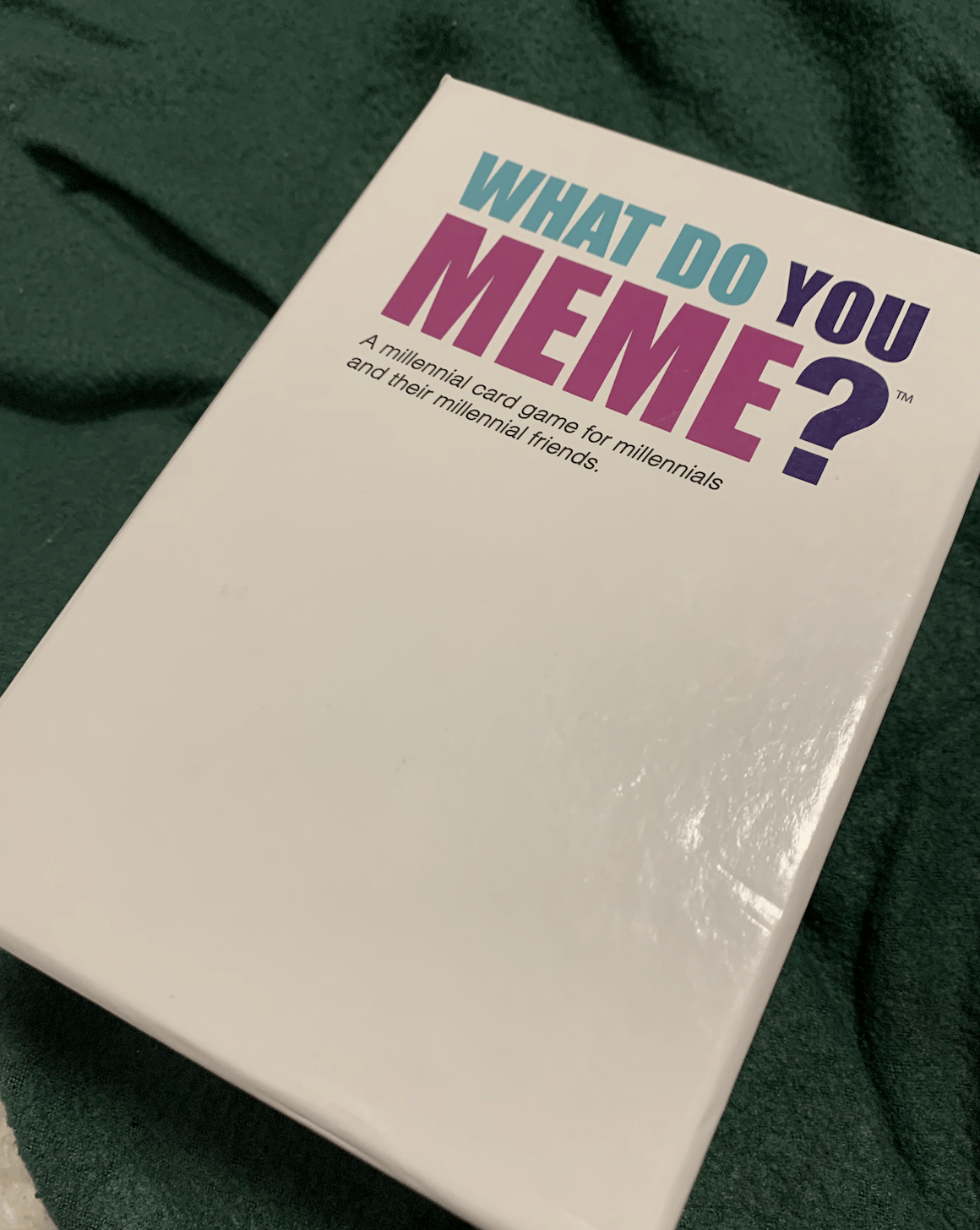Game: What Do You Meme?
- Creators: Elie Ballas, Ben Kaplan, Elliot Tebele
- Target Audience: 17+
- Platform: Analog Card Game
- Players: 3-20 (it’s a party!)
Formal Elements
In addition to being one word off from a popular Justin Bieber song, What Do You Meme is a judging game similar to Cards Against Humanity, except players have to choose the best description for a given meme. There are only two different resources for this game: caption cards and meme cards. Caption cards contain a possible description for the meme or a situation that the meme might apply to. Meme cards just feature an image of a popular meme.


For each round, one person is the judge, and they draw a meme card and show all the players. All the other players have seven caption cards in their hand hidden, and they pick one that best describes the meme card and places it in front of the judge face-down. The judge picks the best caption card, and that person reveals themselves and is awarded the meme card for that round. All players then replentish their hand and the chooser rotates, and a new round begins. Whoever has the most meme cards when the game stops wins.
One interesting formal element is the “Freestyle” caption card. This means that a player can write their own caption if they don’t like any of the other ones in their hand, and that becomes one of the options for the judge to choose from. This allows players’ unique sense of humor to be incorporated into the game, and the specificity of a lot of caption cards lets players get creative about which card they put down for which judge. For example, someone who likes to go to concerts and parties might get different caption cards than a quiet person who likes to stay in and read, even if it’s for the same meme.

Types of Fun
What Do You Meme relies heavily on fellowship; players get to know each other’s sense of humor and can laugh at/with each other without putting anyone in a situation where they could be judged. A lot of the prompts also lead to further discussion as well (for example, when one person put down a caption card that said “When the music stops, your friends are gone, and the drugs wear off and you feel empty inside”, the judge asked the player who put it down whether they’d ever experienced that. This led to sharing of stories as the game paused for a little bit, then resumed, and the players got to know each other more.
The game also relies heavily on expression; players get to use their creativity and show their own thoughts. Since the memes are pretty vague and can be applied to lots of different scenarios, players have different interpretations of what the meme means. Seeing what other players associate with the same image (which are often wildly different things!) is very interesting, and it reveals a lot about what other players think is funny!
Why Does It Work? How Can It Be Improved?
What makes this game work so well is its simplicity. The rules are almost exactly the same as every other judging game, so anyone who’s ever played Cards Against Humanity or Apples to Apples or anything similar can immediately catch on, no matter how many glasses of wine they’ve had. This allows players to use their brain capacity thinking of fun prompts or creative ways to connect the meme to their caption cards, and in general just talking and hanging out with their friends, instead of “how do I earn points again?” or “how many cards should I be putting down?” or “what does this card do?”. While adding more elements and complicating the rules could result in fun twists and turns, the simplicity makes the barrier to entry super low – in fact, out of all the games I played this quarter, it was the easiest one to catch onto as a newcomer!
One improvement I could think of is having caption cards that relate to other people playing the game (for example, “when the person to your left falls down during their performance” or something along those lines). This allows for more relatability to the cards especially if they happen to not describe scenarios that are applicable to the players.
Compared to Cards Against Humanity, I liked this game better mainly because the images are more open to interpretation and humorous than the written black cards. Sometimes, if you have a bad hand, there’s just no way to make any of the cards make sense in Cards Against Humanity, but I ran into this issue a lot less in What Do You Meme. Even if the cards weren’t directly applicable, there was usually a way to connect it to the meme.
Vulnerability
This game can be played with both close friends and strangers because it does not require much disclosure to get started! The generic memes allow for a level of removal from the scenarios being described and make them seem more hypothetical; therefore, a player doesn’t need to share anything about how their actual life relates to the cards unless they want to (which happens a lot in games with close friends). Furthermore, the caption cards are written out and given to the players; they did not make up the cards, so none of the other players are judging them for what they put down. The Freestyle cards are an exception to this, but there’s no situation where a player is forced to play a freestyle card – it’s just one option out of many!
Overall, What Do You Meme is a great game to play with either friends or strangers at a party, and I really enjoyed it!



